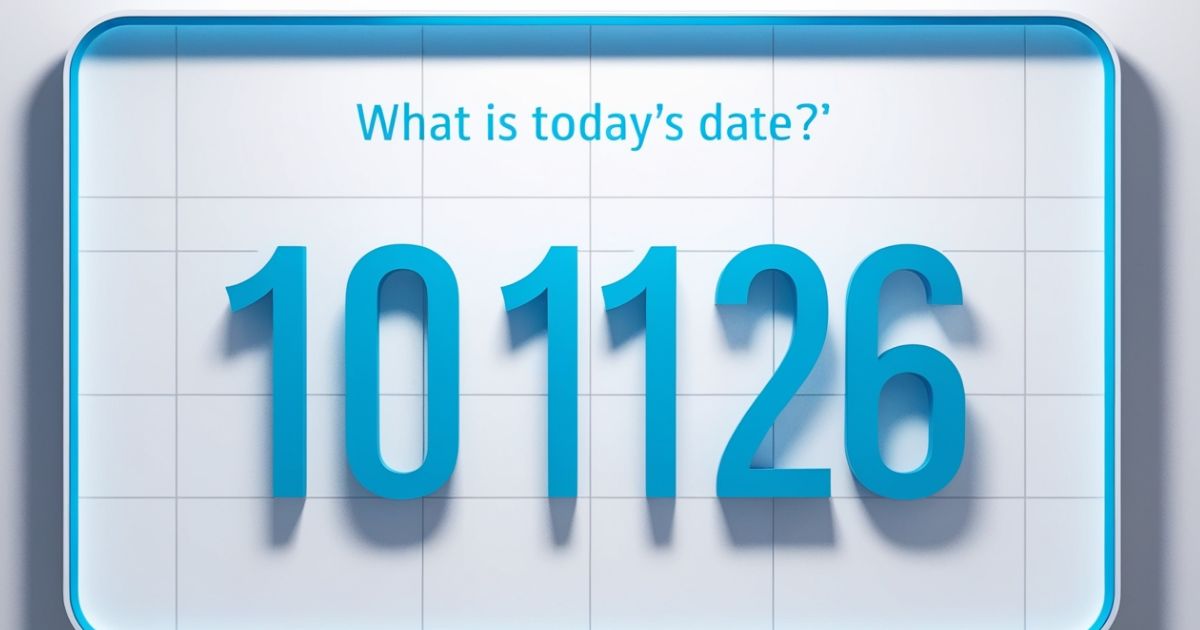In our increasingly interconnected world, something as simple as today’s date can have profound implications for our personal organization, professional communications, and overall productivity.
Whether you’re scheduling international meetings, tracking progress on important goals, or simply trying to stay organized, understanding how to properly reference and utilize today’s date is an essential skill. This comprehensive guide explores everything you need to know about date awareness and how to leverage it effectively in your daily life.
Today’s date in mm/dd/yyyy format:
Today’s date in the American format is 04/11/2025.
This format, with the month preceding the day, is predominantly used in the United States and a handful of other countries. The mm/dd/yyyy format evolved from the traditional way dates were spoken aloud in American English—for example, “April 11th, 2025.” This convention has become deeply embedded in American business documents, government forms, and digital systems.
The American date format prioritizes the contextual information most people use first in conversation (the month), followed by the specific day. While this may seem intuitive to Americans, it creates a significant point of divergence from international standards that can lead to date confusion when communicating globally.
Today’s date in dd/mm/yyyy format:
Today’s date in the international format is 11/04/2025.
The dd/mm/yyyy format is widely used throughout Europe, Asia, Australia, and most of the world outside North America. This format follows a logical progression from the smallest unit of time (day) to the largest (year), creating a consistent hierarchy that many find intuitive.
The International Organization for Standardization (ISO) recognizes this logical progression in its ISO 8601 standard, though the official ISO format actually arranges elements from largest to smallest (YYYY-MM-DD) to facilitate computer sorting and database management.
Understanding both these common date formats is crucial for avoiding miscommunication, especially when working across borders or with international communications.
CURRENT WEEK NUMBER – What week of the year is it?
The current week number is 15 of 2025.
Week numbering provides another temporal reference point that’s particularly valuable in certain contexts:
- Project management: For establishing weekly milestones and reporting cycles
- Manufacturing: In coordinating production schedules and inventory management
- Education: For organizing academic terms and assessment periods
- Business: For financial reporting and operational planning
According to the ISO standard, the first week of the year contains the first Thursday of the year, which means the first week may actually include days from the previous year. This standardization helps ensure consistency in week counting across years.
“Week numbers offer a powerful way to chunk time into manageable periods for planning and review. They create natural checkpoints for evaluating progress toward quarterly and annual goals.” – Time Management Institute
Avoiding Confusion with Date Formats
The ambiguity between mm/dd/yyyy and dd/mm/yyyy formats creates genuine risks for misunderstanding. Consider these examples:
- 03/04/2024 could represent March 4th or April 3rd
- 3/4/2025 might indicate March 4th or April 3rd
- 4/3/2025 could be interpreted as April 3rd or March 4th
These misinterpretations can lead to missed deadlines, scheduling conflicts, data errors, and other costly mistakes. Research suggests that date confusion costs businesses millions annually through operational inefficiencies and miscommunications.
To avoid such confusion, especially in cross-border communications, consider these best practices:
- Write out the month name instead of using numbers (e.g., January 21, 2025 or 21 January 2025)
- In the US, consistently use the mm/dd/yyyy format
- In the UK and internationally, adhere to the dd/mm/yyyy convention
- For critical communications, specify the format you’re using
- Consider using the ISO 8601 standard (YYYY-MM-DD) for technical documentation
By being mindful of potential date miscommunications, you can prevent confusion and ensure that your messages are understood as intended.
Stay Organized with Today’s Date
Date awareness serves as a fundamental building block for personal and professional organization. By consciously incorporating today’s date into your organizational systems, you create a temporal framework that supports better decision-making and time management.
Daily Planning and Review
Beginning each day with awareness of today’s date establishes context for your activities. This simple practice:
- Anchors your plans within the larger framework of weekly and monthly goals
- Creates a clear delineation between yesterday’s accomplishments and today’s priorities
- Helps calibrate your sense of time passing, preventing projects from drifting
- Reinforces deadline awareness for approaching commitments
Many productivity experts recommend starting your day by writing today’s date at the top of your to-do list or journal. This date stamp creates both a psychological anchor and a practical reference point.
Event Management and Memory Support
Our memory for dates is notoriously unreliable, which is why externalized systems are so important. Using today’s date as a reference point helps with:
- Tracking when you last connected with important friends, family, and colleagues
- Setting appropriate reminders for upcoming obligations
- Documenting when important decisions were made or information was received
- Creating chronological records that can be reviewed and analyzed later
Research shows that people who maintain dated records demonstrate better recall of events and experience less stress related to information management.
Calendar Systems and Integration
Whether digital or analog, calendars serve as the primary tool for date-based organization. Effective calendar management involves:
- Using consistent date formats across all your systems
- Implementing color-coding or tagging to categorize different types of events
- Establishing regular reviews of upcoming dates (daily, weekly, monthly)
- Maintaining appropriate time horizons for different types of planning
Digital calendars offer additional advantages through integration with other productivity tools, enabling automated reminders and synchronized scheduling across devices and platforms.
Tracking Progress with Date Awareness
One of the most powerful applications of date awareness is in tracking progress toward goals. By associating specific dates with actions and outcomes, you create a measurable framework for advancement.
Fitness Goals
Fitness goals benefit tremendously from date-based tracking. Consider these applications:
- Recording workout dates creates visible evidence of consistency
- Tracking performance metrics against specific dates reveals improvement trends
- Planning rest days and intensity cycles requires precise date scheduling
- Preparing for time-bound events (races, competitions) involves date-based training schedules
A simple calendar with X’s marking completed workout days can create powerful visual motivation by displaying your consistency streak. Research shows that this visible record increases accountability and reduces the likelihood of breaking the chain.
Financial Goals
Financial goals similarly benefit from temporal structure:
- Recording account balances on specific dates allows for trend analysis
- Tracking spending patterns by date reveals cyclical behaviors
- Setting date-based milestones creates interim targets toward larger financial freedom
- Correlating financial behaviors with other life events requires date-based record-keeping
Many financial experts recommend monthly “money dates” with yourself or your partner to review your progress using these date-based metrics and make adjustments to your strategy.
Learning Goals
Acquiring new skills or knowledge is a process best tracked through time:
- Documenting study sessions by date demonstrates commitment to learning
- Spacing learning sessions optimally requires date-based planning
- Testing knowledge retention at specific intervals improves long-term mastery
- Setting certification or competency milestones by date creates clear targets
Research in educational psychology confirms that spaced repetition—reviewing material at specific, increasing intervals—significantly improves retention compared to cramming. Date-based learning schedules facilitate this optimal approach.
Conclusion on today’s date
The simple act of noting and using today’s date serves as a powerful foundation for organization, goal achievement, and effective communication. While it may seem trivial, date awareness touches nearly every aspect of our personal and professional lives.
By understanding different date formats, implementing consistent date practices, and leveraging dates for tracking and planning, you can enhance your productivity, reduce stress, and improve coordination with others. These small habits compound over time to create significant improvements in how we manage our lives and work.
In our global environment, being mindful of how dates are represented across cultures is increasingly important. Taking the extra moment to ensure clarity in date references prevents misunderstandings and demonstrates professionalism and cultural awareness.
As we navigate our complex world, the humble date remains one of our most valuable organizational tools—simple yet profoundly useful for creating order and meaning in our daily activities.
Read This Post: 116 Foot Puns That Will Have You Toe-tally Laughing!
FAQ’s
How do Americans write today’s date?
Americans typically write today’s date as 04/11/2025 (mm/dd/yyyy), placing the month before the day.
What is the date mm dd yy?
The date format mm/dd/yy is an abbreviated American format showing month/day/year, with today being 04/11/25.
Why is today’s date 123123?
Some systems use numeric coding like 123123 for dates based on various technical standards (Julian dating, ordinal dates, or programming codes).
What date is it today or what day is today?
Today is Friday, April 11, 2025 (the date), which is the fifth day of the business week (the day).
| Date Format | Today’s Written Format | Primarily Used In |
| mm/dd/yyyy | 04/11/2025 | United States |
| dd/mm/yyyy | 11/04/2025 | Europe, Asia, Australia |
| yyyy-mm-dd | 2025-04-11 | ISO standard, technical applications |
| Month Day, Year | April 11, 2025 | Formal American writing |
| Day Month Year | 11 April 2025 | Formal International writing |

Hello, I’m Daisy Sadie, a writer at Azaadpuns. I explore the dynamic world of puns and wordplay, delivering captivating linguistic twists that will make you laugh and groan. Join me on Azaadpuns.com for the latest in clever wordplay that makes language fun again.

